NCERT Solutions for Class 6 Science - Getting to Know Plants
Detailed answers of all the NCERT questions of the chapter "Getting to Know Plants" are provided in the document to help you in clearing all your concepts covered in the syllabus.
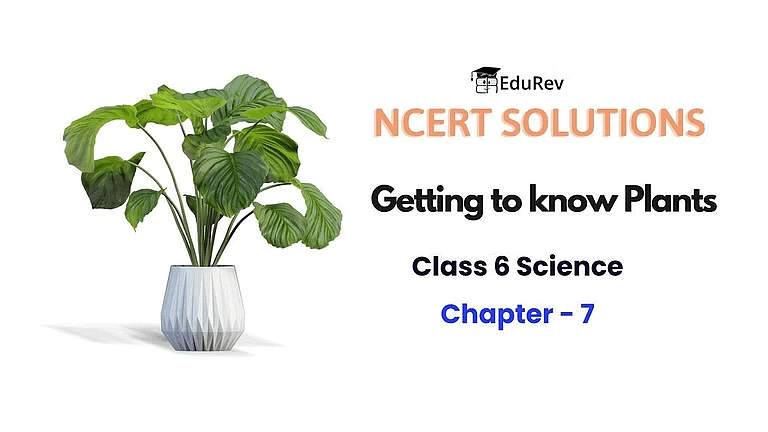
Exercises
Q1. Correct the following statements and rewrite them in your notebook.
(a) Stem absorbs water and minerals from the soil.
Ans: Roots absorb water and minerals from the soil.
 View Answer
View Answer 
The roots are the part of the plant that grows underground. They have tiny hairs that help them take in water and minerals from the soil, which are essential for the plant's growth.
 Roots
Roots
(b) Leaves hold the plant upright.
Ans: Stem hold the plant upright.
 View Answer
View Answer 
The stem is the main support of the plant. It holds the leaves and flowers up so they can get sunlight. If the stem is strong, the plant can stand tall.
(c) Roots conduct water to the leaves.
Ans: Stem conduct water to the leaves.
 View Answer
View Answer 
While the roots absorb water, it is the stem that transports this water all the way to the leaves where it is used for photosynthesis (the process plants use to make food using sunlight).
 Parts of Plants and their Importance
Parts of Plants and their Importance
(d) The number of petals and sepals in a flower is always equal.
Ans: The number of petals and sepals in a flower may not be always equal.
 View Answer
View Answer 
In some flowers, there might be more petals than sepals or vice versa. The number of each can vary, and this diversity is what makes flowers look different from each other. Petals and Sepals
Petals and Sepals
(e) If the sepals of a flower are joined together, its petals are also joined together.
Ans: If the sepals of a flower are joined together, its petals are separate and not joined together.
 View Answer
View Answer 
- Sepals protect the flower bud before it opens.
- Even if the sepals are stuck together, the petals can still be separate, showing that flowers have different structures and do not always follow the same pattern.
(f) If the petals of a flower are joined together, then the pistil is joined to the petal.
Ans: If the petals of a flower are joined together, then the pistil may or may not be joined to the petal.
 View Answer
View Answer 
- The pistil is the part of the flower that produces seeds.
- Sometimes, the petals can be stuck together, but the pistil might still be separate, showing that flowers can have different arrangements of their parts.
Q2. Draw (a) a leaf, (b) a taproot and (c) a flower, you have studied for Table 4.3.
Ans:
(a) Parts of a Leaf (b)
Parts of a Leaf (b)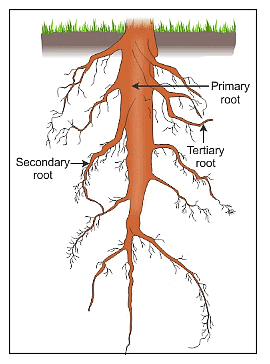 Tap Root(c)
Tap Root(c) Parts of FlowerQ3. Can you find a plant in your house or in your neighborhood, which has a long but weak stem? Write its name. In which category will you place it?
Parts of FlowerQ3. Can you find a plant in your house or in your neighborhood, which has a long but weak stem? Write its name. In which category will you place it?
Ans: Yes, there is a plant in our house which has a long but weak stem. It is called jasmine and it comes in the category of climbers.
Learn more about the different types of Plants like Trees, Herbs, Shrubs, Climbers, Creepers through this video:
Q4. What is the function of a stem?
Ans:
A stem performs following functions:
(i) The stem and its branches hold leaves to get maximum sunlight.
(ii) It transports water from roots to different parts of the plant.
(iii) It transports food from leaves to different parts of the plant.
(iv) It bears leaves, flowers and fruits.
Q5. Which of the following leaves have reticulate venation?
Wheat, tulsi, maize, grass, coriander (dhania), China rose
Ans: Reticulate venation refers to the arrangement of veins in a leaf where they form a web-like structure. Smaller and more delicate veins emerge from the midrib and spread in the entire leaf.
Among the provided options, three plants exhibit reticulate venation:
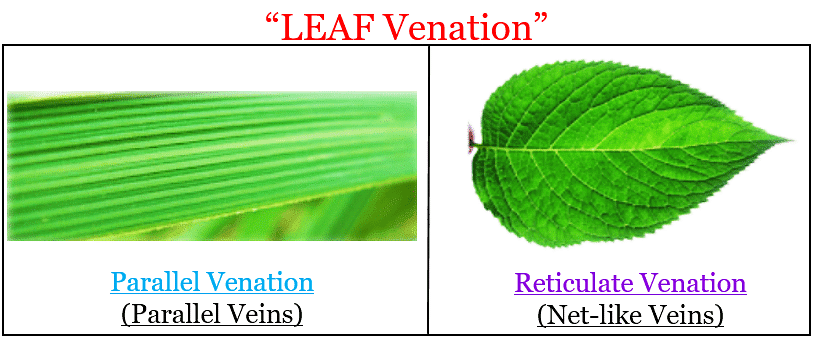 Leaf Venation
Leaf Venation
- Tulsi: The leaves of Tulsi showcase reticulate venation. When you observe a Tulsi leaf closely, you'll notice a beautiful network or mesh-like pattern formed by its veins.
- Coriander (Dhania): The leaves of Coriander, also known as Dhania, display reticulate venation. The veins in the leaves create an intricate network, making them stand out.
- China Rose: The leaves of China Rose, a flowering plant, also have reticulate venation. You can identify this characteristic network pattern in the structure of its leaves.
Q6. If a plant has fibrous root, what type of venation do its leaves have?
Ans: If a plant has a fibrous root, its leaves have parallel venation. This means that the veins in the leaves run parallel to each other, providing structural support and efficient transport of water and nutrients.
Q7. If a plant has leaves with reticulate venation, what kind of roots will it have?
Ans: If a plant has leaves with reticulate venation, it will have a tap root. In a taproot system, there is a primary, thick root (the taproot) from which smaller, lateral roots branch out.
Q8. Is it possible for you to find out whether a plant has taproot or fibrous roots by looking at the impression of its leaf on a sheet of paper?
Ans: Yes, it is possible to find whether a plant has taproot or fibrous roots by looking at the impression of its leaf on a sheet of paper. If the veins in the leaf impression exhibit parallel arrangement, the plant likely has fibrous roots. If the veins form a network or mesh-like pattern, the plant is likely to have a taproot system.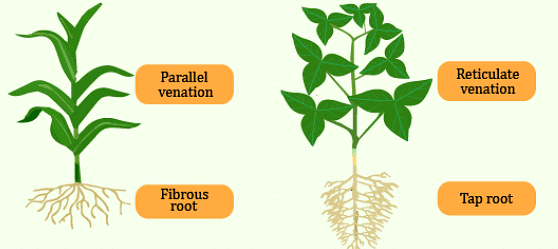 Venation and Roots
Venation and Roots
Q9. What are the parts of a flower?
Ans: The parts of a flower are sepals, petals, stamens and pistil. These parts play crucial roles in reproduction and are essential components of the plant's reproductive structures.
 Parts of Flower
Parts of Flower
- Sepals: Sepals are the outermost whorl of floral parts, usually green and leaf-like. Their main function is to protect the flower during the bud stage. They enclose and shield the inner floral parts, providing support and acting as a protective covering.
- Petals: Petals are often brightly colored and contribute to the visual attractiveness of the flower. Their primary function is to attract pollinators like bees, butterflies, and birds. The color, fragrance, and patterns of petals are key factors that lure pollinators, aiding in the process of pollination.
- Stamens: Stamens are the male reproductive organs of a flower and consist of two main parts: the filament and the anther. The filament provides support to the anther, where pollen grains are produced. The pollen contains male gametes, and the stamens play a crucial role in the transfer of pollen from the male reproductive organs to the female reproductive organs for fertilization.
- Pistil: The pistil is the female reproductive organ of a flower and comprises three main parts: the stigma, style, and ovary.
Stigma: The stigma is the sticky, often knob-like structure at the top of the pistil. It receives pollen during pollination.
Style: The style is the slender tube that connects the stigma to the ovary. It provides a pathway for pollen to travel from the stigma to the ovary.
Ovary: The ovary is the enlarged base of the pistil. It contains ovules, which are potential seeds. After fertilization, the ovary develops into a fruit, protecting and nourishing the seeds.
Q10. From the following plants, which of them have flowers?
Grass, maize, wheat, chilli, tomato, tulsi, peepal, shisham, banyan, mango, jamun, guava, pomegranate, papaya, banana, lemon, sugarcane, potato, groundnut
Ans: The plants which have flowers are grass, maize, wheat, chilli, tomato, tulsi, peepal, shisham, banyan (flowers lie inside its fruits), mango, jamun, guava, Pomegranate, papaya, banana, lemon, sugarcane, potato, groundnut
Q11. Name the part of plant which produces food. Name the process.
Ans: Leaves make food in a process called photosynthesis. It's like the plant's cooking method. Photosynthesis
Photosynthesis
- Leaves - The Plant's Kitchen: Leaves are like the kitchen where the plant cooks its food.
- Photosynthesis - The Cooking Process:
- Ingredients:
Sunlight (from the sun)
Carbon Dioxide (from the air)
Water (from the ground) - Mixing: Leaves mix these ingredients using chlorophyll.
- Outcome: Leaves create their own food, a kind of sugar.
This food gives the plant energy.
So, in short, leaves use photosynthesis to cook up their food with sunlight, air, and water.
Q12. In which part of a flower, you will find the ovary?
Ans: Ovary is located in the lowermost and swollen part of the pistil of flower.
Q13. Name two plants in which one has joined sepals and the other has separate sepals.
Ans:
Joined Sepals:
- Datura: The sepals in Datura flowers are fused, forming a distinct cup-like structure at the base of the flower.
- Cotton: Cotton flowers also have joined sepals, contributing to the unique appearance of the flower bud.
Separated Sepals:
- Lotus: The sepals of the lotus flower are separate, distinct from each other, and encircle the base of the flower.
- Rose: Roses are known for their separate sepals, where each sepal is individual and not fused with others.
|
70 videos|150 docs|104 tests
|
FAQs on NCERT Solutions for Class 6 Science - Getting to Know Plants
| 1. What are the different parts of a plant and their functions? |  |
| 2. How do plants reproduce? |  |
| 3. What is photosynthesis and why is it important for plants? |  |
| 4. What are the different types of plants based on their habitats? |  |
| 5. How do plants adapt to their environment? |  |

















